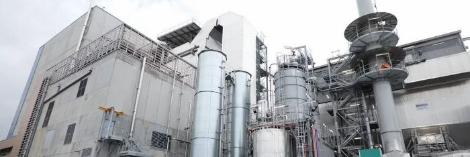Old furniture provides warmth in Le Havre
April 2025
Agence pour l’Environnement et la Maîtrise de l’Energie (ADEME)
Suez has just inaugurated a new energy production plant near Le Havre. Called Biosynergy, it will be fuelled by wood waste, i.e. used carpentry and furniture, as well as solid recovered fuel (SRF), all produced locally.

An untapped waste resource
It all began ten years ago, when ADEME, together with the Normandy and Île-de-France regions, launched a study to characterise the source of contaminated wood produced in the Seine Valley. As a company specialising in waste management, Sita (now Suez) actively contributed to this study. Until then, the old wooden furniture and joinery it collected went straight to landfill or was exported to other countries for recycling. ‘Once painted, varnished or treated, wood cannot be burned in a conventional boiler. The fumes must be purified to prevent pollutants from being released into the atmosphere,’ explains Guillaume Lefrançois, regional director at ADEME Normandy. The aim of the study was to find local outlets that would create value in Normandy for this wood waste.’ At Suez, the Biosynergy project emerged naturally: ‘We already had the idea of building a new waste-to-energy plant in this area. There was strong demand for renewable energy, both from the city of Le Havre and from manufacturers in the port area,’ says Antoine Girardet, Director of Energy Recovery for the Greater West region at Suez.
7,700 kt of non-hazardous contaminated wood waste is available each year in France.
One-third of this waste is exported, mainly for recycling in neighbouring countries. The remaining two-thirds is sent to storage and landfill sites.
50,000 tonnes of greenhouse gas emissions avoided
The plant was inaugurated in November 2024. Today, it is operating at 100% of its nominal capacity (43.5 MW). ‘Thanks to this plant, we are recovering 90,000 tonnes of waste per year to produce 300,000 MWh of energy, which we distribute in the form of heat and steam,’ says Antoine Girardet. On the one hand, we have contributed to the expansion of the Résocéane district heating network in the south of the Le Havre metropolitan area and, on the other, we have participated in the decarbonisation strategy of three industrial sites (those of Yara, Chevron and Safran). We can supply each of them according to their needs: low-pressure hot water at 90°C for district heating and very high-pressure steam for industrial processes.’ The distribution of these two types of flows is fairly flexible. ‘In summer, as homes do not need to be heated, we redirect a large part of our production to industrial customers, who can then reduce their reliance on fossil fuels. As a result, over the year, we prevent 50,000 tonnes of greenhouse gas emissions.’
A whole local circular economy
Because it recycles waste that was previously unused, but also because it helps to produce low-carbon energy without affecting woodland, the construction of the plant received financial support from ADEME through the Chaleur fund. But it is part of a wider regional ecosystem. ‘At Suez, in line with our short loop strategy, we try as far as possible to collect, treat and recover waste within the same region. That’s why, a few kilometres from Biosynergy, we have invested in the former brownfield site of the International Centre for the Treatment and Recycling of Hazardous Waste (known as ‘Citron’), which was decontaminated by ADEME in 2016, to create a wood waste treatment platform,’ adds Antoine Girardet. At this site, we extract parts such as screws and other metals from furniture and joinery, which can then be sent to a recycling facility. We then shred the remaining wood and send it to the power plant. In the same factory, called Trinergy, other non-recyclable and non-hazardous waste (tyres, soiled paper, animal fats, etc.), also collected in the Valley, is prepared and transformed into solid recovered fuel (SRF) to facilitate its energy recovery. All of this creates value for the region.